The CCC System’s 21 care components represent a free coded standardized framework for classifying each of the three interrelated CCC terminologies: CCC of nursing diagnoses, CCC of nursing interventions/actions and CCC of nursing outcomes. They are used to code and classify the six steps/standards of the ANA nursing process: assessment, diagnosis, outcome identification (CCC expected outcomes), planning, implementation (CCC interventions action types) and evaluation (CCC actual outcomes).


Definition
A care component is defined as “a cluster of elements that represent four unique patterns of clinical nursing practice: health behavioral, functional, physiological and psychological.”
Description

The CCC System’s care components were empirically developed by statistically clustering the clinical care concepts from the two original relevant problems/diagnoses and interventions/services vocabulary lists. Each cluster consists of sufficient clinical and statistical data/concepts that warranted a separate care component class and represented clinical nursing practice. The 21 care components (activity, bowel/gastric, cardiac, cognitive/neuro, coping, fluid volume, health behavior, life cycle, medication, metabolic, nutritional, physical regulation, respiratory, role relationship, safety, self-care, self-concept, sensory, skin integrity, tissue perfusion and urinary) are further categorized by the four health patterns listed above.
Each care component represents a cluster of elements designed to classify the terminological concepts used to document, facilitate computer processing and statistically analyze nursing practice for an episode of illness. They are also used to predict care requirements, determine resources, measure outcomes, and link and map the terminologies to each other and to other health-related classifications. They were found to be the most clinically relevant assessment classes, best predictors of health resources, most appropriate standardized framework, and 99% compliant for coding and classifying nursing practice regardless of setting (Holzemer et al., 1997). They can be used to track and measure patient care holistically over time, across healthcare settings, population groups and geographic locations.
Online Table
The table below contains the 21 care components in the CCC System (version 2.5) sorted alphabetically by code. Note that the sort order may be changed by clicking on the column headings in the table.
| CompLetter | CompName | CompDescription |
|---|---|---|
| A | Activity | Cluster of elements that involve the use of energy in carrying out musculoskeletal and bodily actions. |
| B | Bowel/Gastric | Cluster of elements that involve the gastrointestinal system. |
| C | Cardiac | Cluster of elements that involve the heart and blood vessels. |
| D | Cognitive/Neuro | Cluster of elements that involve the cognitive, mental, cerebral, and neurological processes. |
| E | Coping | Cluster of elements that involve the ability to deal with responsibilities, problems, or difficulties. |
| F | Fluid Volume | Cluster of elements that involve liquid consumption. |
| G | Health Behavioral | Cluster of elements that involve actions to sustain, maintain, or regain health. |
| H | Medication | Cluster of elements that involve medicinal substances. |
| I | Metabolic | Cluster of elements that involve the endocrine and immunological processes. |
| J | Nutritional | Cluster of elements that involve the intake of food and nutrients. |
| K | Physical Regulation | Cluster of elements that involve bodily processes. |
| L | Respiratory | Cluster of elements that involve breathing and the pulmonary system |
| M | Role Relationship | Cluster of elements involving interpersonal, work, social, family, and sexual interactions. |
| N | Safety | Cluster of elements that involve prevention of injury, danger, loss, or abuse. |
| O | Self-Care | Cluster of elements that involve the ability to carry out activities to maintain oneself. |
| P | Self-Concept | Cluster of elements that involve an individual's mental image of oneself. |
| Q | Sensory | Cluster of elements that involve the senses including pain. |
| R | Skin Integrity | Cluster of elements that involve the mucous membrane, corneal, integumentary, or subcutaneous structures of the body. |
| S | Tissue Perfusion | Cluster of elements that involve the oxygenation of tissues, including the circulatory and vascular systems. |
| T | Urinary Elimination | Cluster of elements that involve the genitourinary system. |
| U | Life Cycle | Cluster of elements that involve the life span of individuals. |